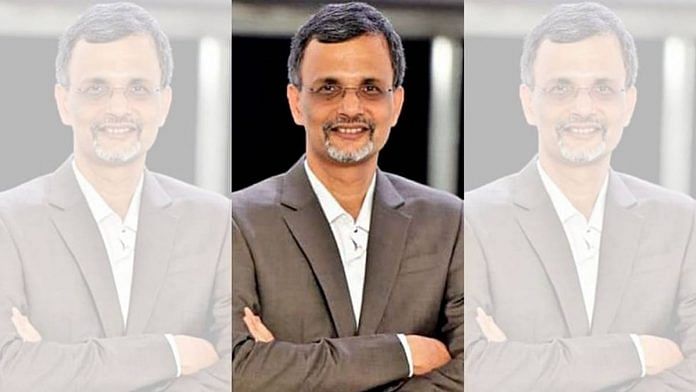New Delhi: The current Chief Economic Advisor (CEA) to the Government of India, V. Anantha Nageswaran, has responded to the arguments of former CEA Arvind Subramanian with an article titled ‘Don’t bet against India’. Last month, Subramanian had written that it would be difficult for India to emerge as an alternative to China in the global economy despite the latter’s status as the “workshop of the world” now facing several challenges.
In their piece published in Foreign Affairs, Nageswaran and Indian Economic Service officer Gurvinder Kaur argue that Subramanian’s datasets do not ally with the current developments in India. They cite the rise of the digital economy, small businesses and an upcoming economic boom to counter Subramanian’s arguments.
Subramanian’s argument
In his article ‘Why India can’t replace China’ co-authored with economist Josh Felman, Subramanian argues that while India looks like a “promised land” in the South Asian context, it’s still at a nascent stage to be considered a replacement for its biggest economic rival, China.
The argument revolves around several macroeconomic indicators, the first being the Gross Domestic Product (GDP), which according to the authors is still struggling to combat the effects of the Covid-19 pandemic.
“Take India’s GDP. It is true that growth over the past two years has been exceptionally rapid, higher than any other major country. But this is largely a statistical illusion…India suffered the worst contraction in output of any large developing country”, they write, adding that the country’s growth rate, at 7 per cent, has been entirely below the benchmark for developing countries.
“In effect, India’s annual growth rate over the past three years has been just two-and-a-half per cent — far short of the 7 per cent annual rate that the country considers as its growth potential. The performance of the industrial sector has been weaker still”, they wrote.
Their case doesn’t rest on the GDP alone. They also argue that foreign companies are relocating their plants out of India, foreign direct investments have derailed and announcements of new investment projects have fallen after a brief uptick following the pandemic.
Subramanian and Felman also cite alleged favouritism towards “national champions” (Indian giants), the distortion of markets through Production Linked Incentive (PLI) schemes and a government running with a high deficit (more spending than earning).
The authors argue that global investors may not be shifting to India as investing here comes with a lot of rists: “Why are global firms reluctant to shift their China operations to India? For the same reason that domestic firms are reluctant to invest: Because the risks remain far too high.”
Also Read: India a relative bright spot in world economy, growing at rates significantly, says IMF
Nageswaran’s reply
The current CEA, Nageswaran, believes that based on current statistics, “most of Subramanian and Felman’s assertions do not stand up to the empirical scrutiny”.
In their article ‘Don’t bet against India’ Nageswaran and Kaur argue that several factors are missing from Subramanian and Felman’s assessment of India’s macroeconomic stability.
On GDP, the authors write that the seeds for slower growth were sown in the decade before 2020. They discuss how money that banks lent after the 2008 recession could not be serviced. Bad debts rose, and consequently, credit growth was hampered in the second decade of the millennium.
“India’s experience was typical for a financial sector crisis, as empirical evidence across developed and developing economies shows that financial system stress after a credit boom tends to have a longer and deeper impact on growth”, they write.
Nageswaran and Kaur add that the demand for credit has picked up and bank credit growth has been in the double digits since April 2022. Capital investments — both government and private — are also up considerably. And, they argue, one also has to take into account the effects of several policy reforms undertaken since 2016, such as the Goods and Services Tax (GST), the new privatisation policy, public investments, and digitalization on a large scale.
They add that under the new GST regime, small businesses have only grown and have started entering the formal system.
The authors also attempt to counter Subramanian and Felman on India’s macroeconomic imbalance, pointing out that India’s inflation rate peaked at just 1.8 per cent above the RBI’s upper tolerance limit in 2022 and did not rise into the double digits. They add that the Budget deficit would have been much lower sans the shocks caused by the pandemic.
Further, they argue that despite the current account imbalance, India’s foreign exchange reserves are still comfortable enough to provide a safe cushion to “withstand future volatility from international markets”. India signed 13 Free Trade Agreements (FTAs), in the past five years, average tariff rates are down and a structural change in India’s FDI has also been observed, they write.
“India has not made democracy a scapegoat for economic underperformance, but a springboard for shared prosperity. For an unbiased view of India’s potential, investors should experience firsthand what promises to be a remarkable economic and social transformation of the country over the next 25 years”, they conclude.
(Edited by Richa Mishra)
Also Read: How India’s economy fared in a year of shocks, aftershocks & slowing global growth



